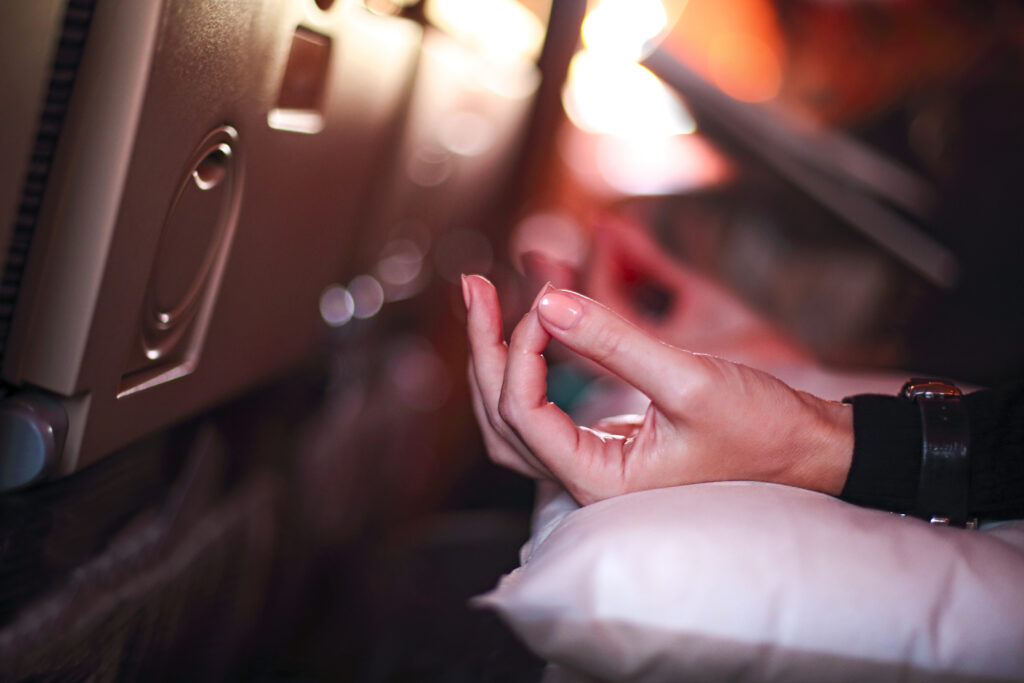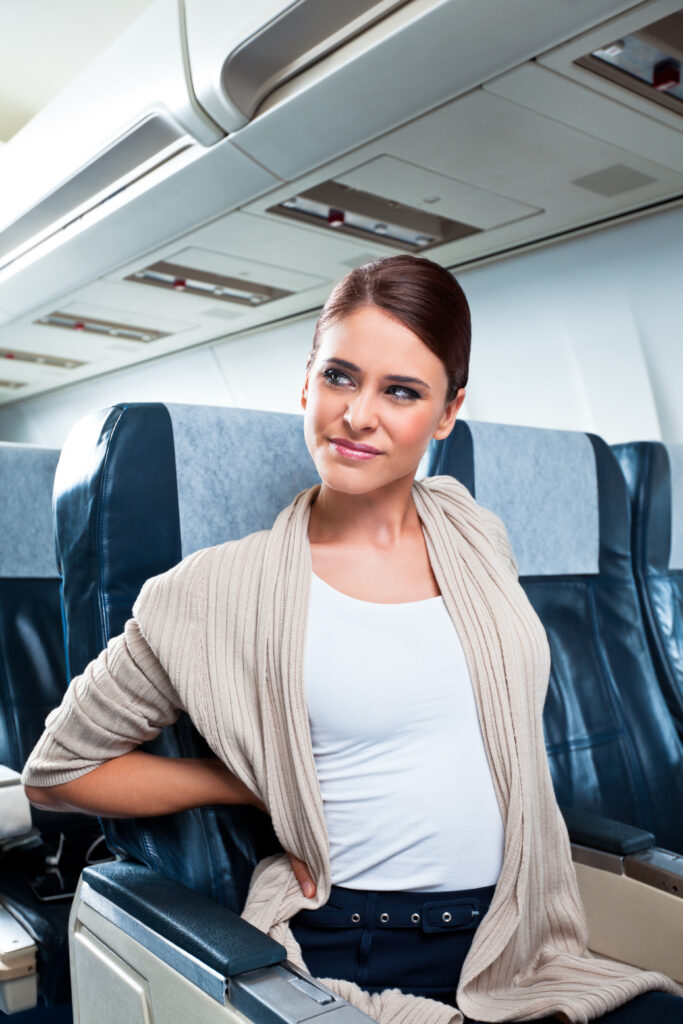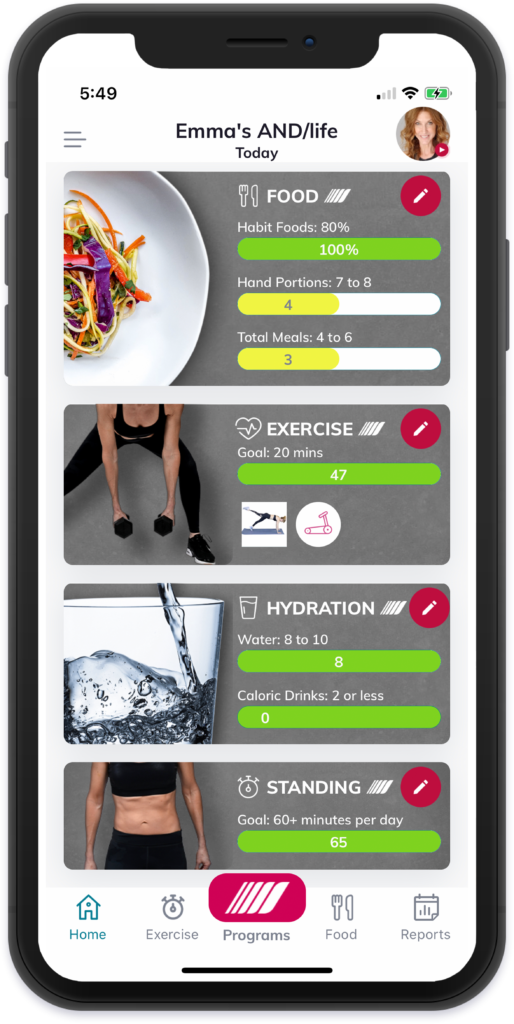5 Ways to Stay Healthy on a Long-Haul Flight
As demand for travel comes roaring back to life, more and more people are heading overseas for leisure and adventure. Back are the days of the dreaded long-haul flights. It’s a necessary obstacle to get to the promise of a vacation paradise.
We all know that flying is hard on the body, so we sat down with self-help author and fitness expert Andrea Marcellus for advice on how to stay healthy and happy on a long-haul flight. As a trusted and respected source for countless media outlets and the creator of the AND/life app, we knew she was the right person to help us out. Here are her top 5 tips.

Tip# 1: Get Rid of Those Pre-Flight Jitters
The amygdala is the emotional center of the brain and becomes activated when we are anxious. Many people are nervous fliers so I’ve created exercises that will short-circuit this part of the brain before boarding their flight. This is one of my favorites:
All you need to do is stand with your knees together and you’re just gonna lift one foot up and down. What you’re going to be doing is connecting your breath to the movement so you’re gonna inhale and raise your foot up for four counts and then lower down on one count. Then on the other leg, you’re gonna inhale and raise up on one count and lower down slowly on four counts. This becomes a balanced move with coordination and breath. When we get these three things going we have activated your cerebellum, prefrontal cortex, and hippocampus. If those three parts of your brain are activated, then the amygdala has to shut off because the brain cannot multitask in this way. Achieving this will allow your body to stop throwing out so much adrenaline and cortisol and help you to relax.
Another way to encourage relaxation is to stimulate the vagus nerve in the jaw. As adults we activate it by chewing; babies do so by sucking on a pacifier. A great way to activate this nerve is by chewing coconut flakes. You can make yourself a mixture with walnuts for a healthy snack if you wish. Coconut flakes take a long time to chew which will provide lots of stimulation to the vagus nerve and thus facilitate calmness.

Tip #2: Stay on Your Food Schedule
You should be treating the time spent on your long-haul flight as if it were your normal, everyday life. A key part of my program is to have my clients make and follow a food schedule. I encourage people to start eating an hour after they wake up just to get their metabolism going. From there you should be eating energy-appropriate foods to get you from meal to meal depending on your activity level. I recommend eating every two to four hours so that your stomach can naturally empty before refilling it. This keeps the metabolism going. You will also need to learn the fine difference between feeling satisfied and full. You are aiming for a feeling of satisfaction when eating. Once you ‘feel full’, you’re actually already overfull. This is something you always want to avoid, especially when flying, due to space constraints.
In tandem with this, travelers should resist the urge to graze while flying. Food and snacks are served at regular intervals on planes, regardless of your internal clock. Constantly eating like that wreaks havoc on the hormonal conversation taking place between the brain and the stomach which will ultimately signal you to stop eating once your hunger is satisfied.

Tip #3: Eat the Correct Foods in Proper Portion
I like measuring food by “hands”, not calories. This is especially useful when flying because you have no control over the meals you are served, rendering calorie counting pointless. Measuring food by hands and food type (protein, fruit, starch) is an easy way to ensure consistent portion intake and control.
We use food to fuel our bodies so it is important to realize that you will need less energy put into your body when flying, especially for long periods of time, due to lack of movement. You will want to eat as clean as possible and focus on consuming energy-appropriate foods out of what the airline serves you, or even better if you’re able to, pack some of your own meals and snacks.
Dried fruits and trail mix may be popular choices for travelers because they are quick and easy, but it’s recommended that you avoid packing them on your next trip. Our body is so inefficient at digesting fructose. If you want to give yourself gas quickly eat a whole bunch of trail mix or dried fruit!
Also, these foods provide a ton of unnecessary energy! Think about it, dried fruit is easy to eat in quantity because it’s shrunken down. When was the last time you ate five pieces of fruit in a row? You are fueling your body with a ton of unneeded energy which is exactly the opposite of what you want to do on a long-haul flight because it becomes stored in the body as fat.
You’ll also want to avoid starchy carbs like white bread while flying. It becomes pure sugar that will enter your system, slow down your metabolism, and require more water to digest.
The foods you do want to focus on are real fruit and vegetables. I have lots of simple snack recipes perfect for flying on my app. Try to stick to lean proteins or nut butters which come in convenient packets that you can squeeze onto an apple.
Eat any and all veggies that the airline serves you and whatever protein is available but definitely leave as much of the starch as you can.

Tip #4: Stretch!!
The biggest complaint from fliers is back pain. The key to alleviating this is to stretch your hip flexors, the crease between your abdomen and your leg. Releasing them will put your pelvis back in position and relieve your lower back. Pressing your hip forward with one leg back will accomplish this. You can do it in the rear of the plane or near the restrooms where you’ll have more room to spread out.
Another option that doesn’t require leaving your seat is to get your ankle up on your knee, (trying not to hit your neighbor of course) pulling your spine forward and back. You’ll be pulling the chest forward to increase the stretch and then back to release it.
An important thing to note here, when you’re sitting on a long flight your muscles are cold, so you don’t want to just hold the stretch. You always want to move in and out of it because you are more likely to cause an injury or an overstretch if you just hold it static.
Your basic gym class hamstring stretch is another great one to release the lower back.

Tip #5: Hacks to Get Some Sleep
We all know it’s tough to get quality sleep on a long plane ride. Sitting upright for all that time is challenging to say the least. If you do try to get some shut-eye to make sure you support your neck. It is crucial to maintain neck alignment so as to avoid injury.
Eye masks are good but if you are like me, you’ll want to take a sweatshirt or pashmina and wrap your entire head into a cocoon. It creates a bubble to sleep in and provides for a deeper slumber.
Also, it helps to elevate your feet on a carry-on bag. It relieves pressure on the lower back and simulates a position more common for sleep which in turn signals the brain that you are safe, which allows the body to relax enough for slumber.


You can access all these tips, custom workouts, instructional videos demonstrating in-flight stretches not mentioned above, and much more by downloading Andrea’s app. It is based on her book “The Way In: 5 Winning Strategies to Lose Weight, Get Strong and Lift Your Life.” Her program fuses exercise, food strategy, and brain training using the neurological principles of habit formation.
For more information on Andrea and her program head to https://www.andlife.com



